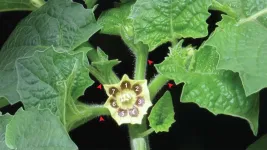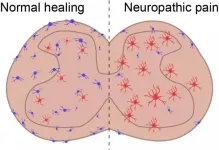Ecology: Gene drives may help control invasive grey squirrel in the UK
2021-03-04
(Press-News.org) Existing gene drive technologies could be combined to help control the invasive grey squirrel population in the UK with little risk to other populations, according to a modelling study published in Scientific Reports.
Gene drives introduce genes into a population that have been changed to induce infertility in females, allowing for the control of population size. However, they face technical challenges, such as controlling the spread of altered genes as gene drive individuals mate with wild individuals, and the development of genetic resistance, which may render the gene drive ineffective.
To address these challenges, Nicky Faber and colleagues used computer modelling to investigate the effectiveness of a combination of three gene drive technologies using the grey squirrel as a case study.
The authors found that the combined gene drive ? HD-ClvR ? effectively suppressed a targeted grey squirrel population, with little risk to other populations by combining the advantages of its individual components: homing, cleave-and-rescue and daisyfield. Homing ensures that the altered gene is passed on to future generations by inserting it into the germline ? the cells that pass on genetic information to offspring. Cleave-and-rescue ensures that offspring with resistant gene variants do not develop. Daisyfield limits the number of altered genes that can be passed on from one individual to the next, thus containing their spread outside the target population. The findings suggest that HD-ClvR may effectively control an invasive species while limiting the risk to native species.
The authors caution that HD-ClvR has not been tested in live animals, and further research is needed before these gene drives could be used. For example, the impacts that an abrupt suppression of the grey squirrel population might have on the ecosystem as a whole would need to be considered.
INFORMATION:
Article details
Novel combination of CRISPR-based gene drives eliminates resistance and localises spread
DOI:
10.1038/s41598-021-83239-4
Corresponding Author:
Nicky Faber
The University of Edinburgh, Edinburgh, United Kingdom
Email: nfaber@outlook.com
Please link to the article in online versions of your report (the URL will go live after the embargo ends):
https://www.nature.com/articles/s41598-021-83239-4
ELSE PRESS RELEASES FROM THIS DATE:
2021-03-04
Using theoretical models of bacterial metabolism and reproduction, scientists can predict the type of resistance that bacteria will develop when they are exposed to antibiotics. This has now been shown by an Uppsala University research team, in collaboration with colleagues in Cologne, Germany. The study is published in the journal Nature Ecology and Evolution.
In medical and pharmaceutical research, there is keen interest in finding the answer to how fast, and through which mechanisms, bacteria develop antibiotic resistance. Another goal is to understand how this resistance, in turn, affects bacterial growth and pathogenicity.
"This kind of knowledge would enable better tracking and slowing ...
2021-03-04
Induced pluripotent stem cells (iPSC) are suitable for discovering the genes that underly complex and also rare genetic diseases. Scientists from the German Cancer Research Center (DKFZ) and the European Molecular Biology Laboratory (EMBL), together with international partners, have studied genotype-phenotype relationships in iPSCs using data from approximately one thousand donors.
Tens of thousands of tiny genetic variations (SNPs, single nucleotide polymorphisms) have been identified in the human genome that are associated with specific diseases. Many of these genetic variants are ...
2021-03-04
A team of scientists from the University of Cologne (Germany) and the University of Uppsala (Sweden) has created a model that can describe and predict the evolution of antibiotic resistance in bacteria. Resistance to antibiotics evolves through a variety of mechanisms. A central and still unresolved question is how resistance evolution affects cell growth at different drug concentrations. The new model predicts growth rates and resistance levels of common resistant bacterial mutants at different drug doses. These predictions are confirmed by empirical growth inhibition curves and genomic data from Escherichia coli populations. ...
2021-03-04
Over evolutionary time scales, a single gene may acquire different roles in diverging species. However, revealing the multiple hidden roles of a gene was not possible before genome editing came along. Cold Spring Harbor Laboratory (CSHL) Professor and HHMI Investigator Zach Lippman and CSHL postdoctoral fellow Anat Hendelman collaborated with Idan Efroni, HHMI International Investigator at Hebrew University Faculty of Agriculture in Israel, to uncover this mystery. They dissected the activity of a developmental gene, WOX9, in different plants and at different moments in development. Using genome editing, they found that without changing the protein produced by the gene, they ...
2021-03-04
CHAPEL HILL, NC - One of the hallmarks of chronic pain is inflammation, and scientists at the UNC School of Medicine have discovered that anti-inflammatory cells called MRC1+ macrophages are dysfunctional in an animal model of neuropathic pain. Returning these cells to their normal state could offer a route to treating debilitating pain caused by nerve damage or a malfunctioning nervous system.
The researchers, who published their work in Neuron, found that stimulating the expression of an anti-inflammatory protein called CD163 reduced signs of neuroinflammation in the spinal cord of mice with neuropathic pain.
"Macrophages are a type of immune cell that are found in the blood and in tissues ...
2021-03-04
What The Study Did: In this study of return-to-play cardiac testing performed on 789 professional athletes with COVID-19 infection, imaging evidence of inflammatory heart disease that resulted in restriction from play was identified in five athletes (0.6%). No adverse cardiac events occurred in the athletes who underwent cardiac screening and resumed professional sports participation.
Authors: David J. Engel, M.D., of Columbia University Irving Medical Center in New York, is the corresponding author.
To access the embargoed study: Visit our For The Media website at this link https://media.jamanetwork.com/
(doi:10.1001/jamacardio.2021.0565)
Editor's Note: The article includes conflict of ...
2021-03-04
What The Study Did: Using reverse transcription-polymerase chain reaction testing, this study found that SARS-CoV-2 was present on the ocular surface in 52 of 91 patients with COVID-19 (57.1%). The virus may also be detected on ocular surfaces in patients with COVID-19 when the nasopharyngeal swab is negative.
Authors: Claudio Azzolini, M.D., of the University of Insubria in Varese, Italy, is the corresponding author.
To access the embargoed study: Visit our For The Media website at this link https://media.jamanetwork.com/
(doi:10.1001/jamaophthalmol.2020.5464)
Editor's ...
2021-03-04
What The Study Did: This study of more than 526,000 procedures across 17 institutions reports a significant decrease in the use of lasers and cryotherapy, retinal detachment repairs and other vitrectomies, beginning mid-March last year and lasting at least until May.
Authors: Mark P. Breazzano, M.D., of the Wilmer Eye Institute at Johns Hopkins Hospital in Baltimore, is the corresponding author.
To access the embargoed study: Visit our For The Media website at this link https://media.jamanetwork.com/
(doi:10.1001/jamaophthalmol.2021.0036)
Editor's Note: The article includes conflict of interest and funding/support disclosures. ...
2021-03-04
What The Study Did: Clinical trial registrations for COVID-19 interventions that were highly publicized during the COVID-19 pandemic compared with treatments not comparably promoted were assessed in this study.
Authors: Nadir Yehya, M.D., M.S.C.E., of the Children's Hospital of Philadelphia, is the author.
To access the embargoed study: Visit our For The Media website at this link https://media.jamanetwork.com/
(doi:10.1001/jamanetworkopen.2021.0689)
Editor's Note: The article includes conflicts of interest and funding/support disclosures. ...
2021-03-04
What The Study Did: Researchers evaluated the feasibility and acceptability of using a mobile robotic system to perform health care tasks such as acquiring vital signs, obtaining nasal or oral swabs and facilitating contactless triage interviews of patients with potential COVID-19 in the emergency department.
Authors: Giovanni Traverso M.B., B.Chir., Ph.D., of the Massachusetts Institute of Technology in Cambridge, Massachusetts, is the corresponding author.
To access the embargoed study: Visit our For The Media website at this link https://media.jamanetwork.com/
(doi:10.1001/jamanetworkopen.2021.0667)
Editor's Note: The article includes conflicts ...
LAST 30 PRESS RELEASES:
[Press-News.org] Ecology: Gene drives may help control invasive grey squirrel in the UK

